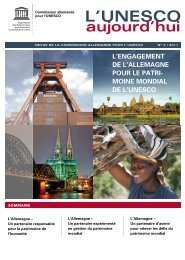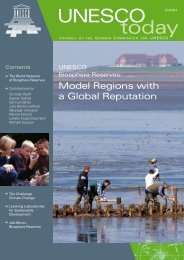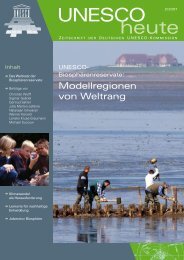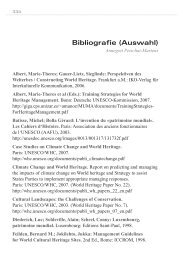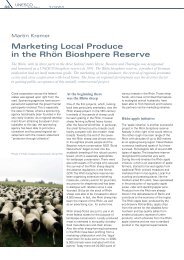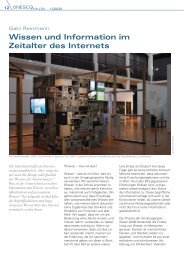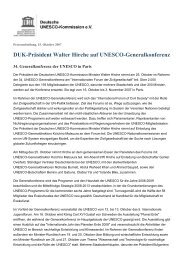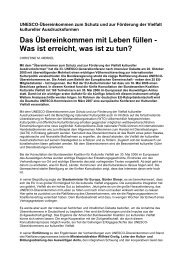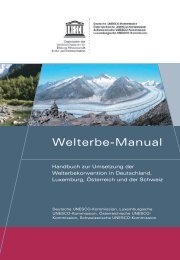Download - UNESCO Deutschland
Download - UNESCO Deutschland
Download - UNESCO Deutschland
Create successful ePaper yourself
Turn your PDF publications into a flip-book with our unique Google optimized e-Paper software.
UNesCO today 3 | 2011 germany’s Commitment to UNesCO’s World Heritage<br />
32<br />
Jasmund National Park is one of the Beech woods that Germany nominated for the<br />
World Heritage List<br />
to assist the German World Heritage sites,<br />
the German Commission for <strong>UNESCO</strong><br />
has published some guidelines, Management<br />
Plans for World Heritage sites.<br />
In What Sense Has the<br />
World Heritage Convention<br />
Been Successful?<br />
The World Heritage Convention is the<br />
most visible and successful <strong>UNESCO</strong><br />
programme. Its success is highlighted by<br />
the number of countries to have ratified<br />
the Convention: 187 out of the 193<br />
<strong>UNESCO</strong> member states have signed it.<br />
The World Heritage List currently comprises<br />
911 sites in 151 countries. Thanks<br />
to this list, an instrument has been created<br />
to fill a gap that existed in all other<br />
international resolutions, recommendations<br />
and charters to conserve both built<br />
and natural Heritage. The World Heritage<br />
List has significantly contributed towards<br />
the effect of the Convention on the public<br />
and to its worldwide success. Protection,<br />
preservation and maintenance are not demanded<br />
by the World Heritage Convention<br />
in a restrictive manner; instead, these<br />
actions are recommended and highlighted.<br />
The World Heritage site title has become<br />
an important instrument of cultural<br />
identification and is now a brand that acts<br />
as a tourist magnet.<br />
Soon, another milestone will have been<br />
reached: in 2012, the Convention will be<br />
40 years old, which coincides with the<br />
predicted inscription of the 1,000th<br />
World Heritage site. The Federal Republic<br />
of Germany might be able to celebrate<br />
its 40th World Heritage site inscription.<br />
On the German Tentative List, there are<br />
several sites that have been put forward<br />
in the context of cross-border, serial<br />
nominations (clusters) for the World Heritage<br />
site List, such as the Houses at the<br />
Weissenhof-Siedlung by Le Corbusier in<br />
Stuttgart, the Prehistoric Pile Dwellings<br />
around Lake Constance in Bavaria and<br />
Baden-Wuerttemberg and the Ancient<br />
Beech Forests in Hesse, Thuringia,<br />
Brandenburg and Mecklenburg-Western<br />
Pomerania. Serial nominations are a<br />
form of international cooperation, which<br />
demonstrate the future viability of the<br />
World Heritage Convention.<br />
They also make the idea behind the<br />
World Heritage Convention clear: it links<br />
both culture and nature conservation,<br />
based on the principle that all cultures are<br />
equal and pinpoints extraordinary sites of<br />
the Earth as the Heritage of Mankind and<br />
that of future generations, independently<br />
of state borders. The World Heritage<br />
Convention of 1972 has become a forum<br />
in which the global community defends<br />
its common Cultural and Natural Heritage<br />
and has proven to be a successful<br />
platform for this activity.<br />
The World Heritage List’s<br />
Universal Claims<br />
The prestige of the World Heritage List<br />
is not only the result of its credibility<br />
and expertise in the selection of the sites.<br />
It is based on the universal claim to represent<br />
all cultures in a balanced fashion<br />
and thus create a rich kaleidoscope from<br />
all the cultures in the world. Due to the<br />
fact that all sites benefit from the prestige<br />
of the World Heritage List, whether<br />
they have already been inscribed on the<br />
List or strive to be, it is important to<br />
make sure that these locations do not<br />
become victims of their own success.<br />
That is why Germany will contribute<br />
towards ensuring that the global strategy<br />
for a sustainable perpetuation of the<br />
World Heritage List is successful and<br />
that a balance between national interests<br />
and international perspectives is reached.<br />
The guiding principles during membership<br />
in the Committee are: the strict application<br />
of the concept of extraordinary<br />
universal value and attention to the<br />
equality and representation of all cultures.<br />
Important aims include the sustainable<br />
development of the World Heritage<br />
sites, paying particular attention to<br />
the impact of climate change, raising<br />
awareness and capacity-building, especially<br />
for younger generations.<br />
Germany actively supports the Global<br />
Strategy for a Representative, Balanced<br />
and Credible World Heritage List. The<br />
fast growth of the World Heritage List in<br />
the past twenty years led to a worrying<br />
imbalance in terms of the geographical<br />
locations and type of sites. Thus, both<br />
on a national and international level,<br />
projects have been launched and<br />
measures taken, following the five Cs




